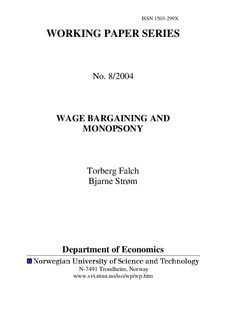| dc.contributor.author | Falch, Torberg | nb_NO |
| dc.contributor.author | Strøm, Bjarne | nb_NO |
| dc.date.accessioned | 2014-12-19T14:31:51Z | |
| dc.date.available | 2014-12-19T14:31:51Z | |
| dc.date.created | 2006-10-04 | nb_NO |
| dc.date.issued | 2004 | nb_NO |
| dc.identifier | 126094 | nb_NO |
| dc.identifier.uri | http://hdl.handle.net/11250/267121 | |
| dc.description.abstract | This paper identifies three possible outcomes of higher relative firm bargaining power in a unionized firm facing an upward sloping labor supply curve. The conventional regime with reduced wage and higher employment corresponds to firm bargaining power below a certain critical value. A supply constrained regime where increased firm bargaining power reduces both wages and employment occurs when the bargaining power is above another critical level. A novel result is that we identify a third regime, with firm bargaining power between these critical levels, where changes in relative bargaining power does not affect wages and employment. | nb_NO |
| dc.language | eng | nb_NO |
| dc.publisher | Institutt for samfunnsøkonomi | nb_NO |
| dc.relation.ispartofseries | Working Paper Series, 1503-299X; 2004:8 | nb_NO |
| dc.title | Wage Bargaining and Monopsony | nb_NO |
| dc.type | Research report | nb_NO |
| dc.contributor.department | Norges teknisk-naturvitenskapelige universitet, Fakultet for samfunnsvitenskap og teknologiledelse, Institutt for samfunnsøkonomi | nb_NO |
